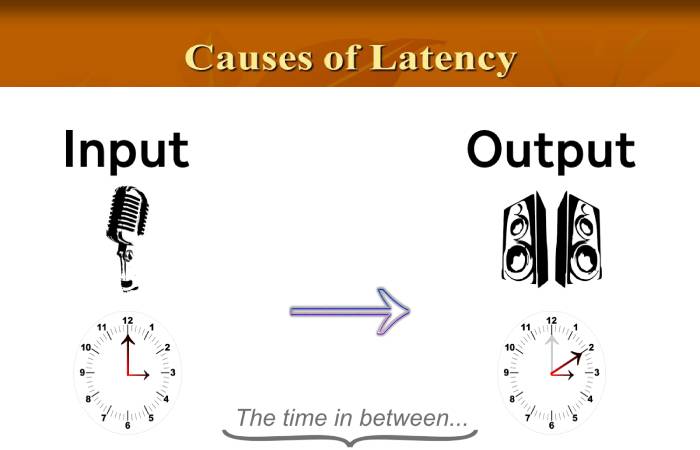Table of Contents
Latency Definition
Latency is the delay between a user’s action and a web application’s response to that action, often referred to in networking terms as the total round trip time it takes for a data packet to travel.
It is generally measured in milliseconds (ms) and is unavoidable due to the way networks communicate with each other. It depends on several aspects of a network and can vary if any of them are changed.
Components of Latency

Four main Components of good document management system affect network latency, including:
Transmission medium
- The physical path between the start point and the endpoint.
- The type of medium can impact latency. For instance, old copper cable-based networks have a higher than modern optic fibres.
Propagation
- The further apart two nodes are, the more there is as latency is dependent on the distance between the two communicating nodes.
- Theoretically, it of a packet going on a round trip across the world is 133ms.
- In actuality, such a round trip takes longer, though latency is decreased when direct connections through network backbones are achieved.
Routers
- The efficiency in which routers process incoming data has a direct impact on it. Router to router hops can increase latency.
Storage Delays
- Accessing stored data can increase it as the storage network may take time to process and return information.
How to Reduce Latency?
- It can be reduced by addressing the components above and ensuring that they are working correctly.
- It can also be reduced using dedicated networks that streamline the network path and provide direct communication between nodes.
- Content Delivery Network (CDN) providers such as StackPath provide customers with private networks that allow them to bypass the public internet.
- These private networks reduce latency by delivering more efficient paths for data packets to travel on.
How does Latency work?
Let’s look into how latency actually works and how, as a user, you’re usually impacted by it. Consider that you are buying a product through an online shop, and you press the “Add to Cart” button for a product you like.
The chain of events that occur when you press that button is:
- You press the “Add to Cart” button.
- The browser identifies this as an event and initiates a request to the website’s servers. The clock for latency starts now.
- The request travels to the site’s server with all the relevant information.
- The site’s server acknowledges the request, and the first half of the latency complete.
- The request gets accepted or rejected and processed.
- The site’s server replies to the request with relevant information.
- The request reaches your browser, and the product gets added to your cart. With this, the latency cycle complete.
- The time it takes for all these events to complete know as latency.
Causes of Latency

Now, where does latency come from? 4 main causes can affect network latency times. These include the following:
- Transmission mediums such as WAN or fibre optic cables all have limitations and affect latency just due to their nature.
- Broadcast is the amount of time it takes for a pack to travel from one source to another (at the speed of light).
- Routers take time to examine the header information of a packet and, in some cases, add additional info. Each hop a box takes from router to router upsurges the latency time.
- Storage delays can occur when a packet store or retrieved, resulting in a postponement caused by intermediate plans like switches and bridges.
Latency vs Bandwidth vs Throughput
- Your network and application performance depends on latency, bandwidth, and throughput, but it’s important not to confuse one with the other.
- Bandwidth is the quantity of data that can pass through a network at any given time. Consider bandwidth as how narrow or wide a pipe is.
- A wider line allows for more data to push through. On the other hand, throughput is the amount of data that can be transferred over a given period.
- An efficient network connection comprise of low latency and high bandwidth. This allows for maximum throughput.
- The bandwidth can only increase by a finite amount as latency will eventually create a bottleneck and limit the amount of data transferred over time.
Examples of Latency
High latency can adversely affect your network’s performance and greatly reduce how quickly your application communicates with users. A content delivery network allows customers to reach their users in the most efficient manner possible. These delivery channels greatly reduce the network lag between the user and the application.
You can pattern the network of your internet connection with any website bypassing its web address or IP address in the command prompt on a Windows or Mac. Here is an example of the command prompt on Windows:
C:\Users\username>ping www.google.com
Pinging www.google.com [172.217.19.4] with 32 bytes of data:
- And also, Reply from 172.217.19.4: bytes=32 time=47ms TTL=52
- Reply from 172.217.19.4: bytes=32 time=45ms TTL=52
- And also, Reply from 172.217.19.4: bytes=32 time=47ms TTL=52
- Reply from 172.217.19.4: bytes=32 time=43ms TTL=52
Ping statistics for 172.217.19.4:
- Packets: Sent = 4, Received = 4, Lost = 0 (0% loss),
Approximate round trip times in milli-seconds:
- Minimum = 43ms, Maximum = 47ms, Average = 45ms
Here you can see the result of pinging www.google.com. The statistics show that the average time it takes for a roundtrip between the given PC and Google’s network is 39ms.
Conclusion
It takes for a data packet to travel from the sender to the receiver and back to the sender. It high can bottleneck a network, reducing its performance.
You can make your web applications less latent by using a CDN and a private network backbone to transfer data.
Also Read: OnePlus 9 Pro Review – Deals, Design, Display, and More
Related posts
Featured Posts
Startup First Office – Definition, How To Set Up, and More
Startup First Office Definition A startup’s first office to use Project management software by an entrepreneur to seek, develop, and validate…
Oppo Find X3 Lite Review – Price, Release Date, and More
The Oppo Find X3 Lite lacks a bit of wow factor, but in a way, that’s also its strength, offering…




Review Latency – Definition, Components, How to Reduce, and More.